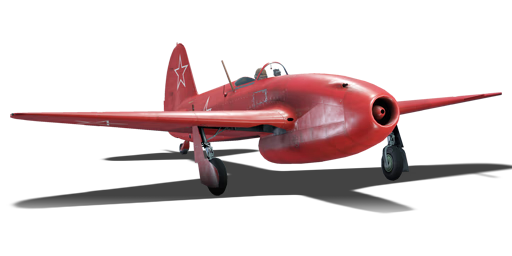



By 1946, the Yakovlev "Yak-Jumo" project to build a single-engine jet fighter with a reverse-engineered Junkers Jumo 004 engine (dubbed the RD-10) hammered into the existing Yak-3 fuselage was well underway, but a few setbacks meant that the full production variant, the Yak-15, could not be fully produced in the required numbers for the October Revolution Air Parade on November 7th. As such, a special variant was quickly ordered for the parade, with much of the unnecessary/untested parts being left out to save time. As such, this special Yak-15 was missing the armour plating and quite a few instruments and avionics, and these aircraft were not even fitted with guns. Some planes had extra fuel tanks installed where the missing guns were supposed to be. Finally, these 15 aircraft were given a bright-red paint scheme for the parade. To save time as the program was already behind schedule, shortly after the parade two of these aircraft were quickly fitted with armour and a single NS-23 23 mm cannon to begin state acceptance trials.
It is also worth noting that the "Yak-15P" designation never actually existed, only being used unofficially many years later to differentiate the special first 15 rushed aircraft from proper production Yak-15s, and it is unknown whether the P in Yak-15P stands for "Parade" or "Pre-production".
The Yak-15P, introduced in Update 1.31, is a very peculiar aircraft among all the early jets of War Thunder. Unlike the only other jet in history to be successfully derived and mass-produced from a pre-existing piston fighter, the Swedish J21R, the Yak-15P does not sacrifice its familiar flight performance heavily. Instead, the Yak-3P retains its incredible handling characteristics familiar to previous Yak-3 pilots, allowing it to swiftly outmanoeuvre most jet aircraft it faces. The biggest drawback however is the low top speed and horrible compression at high speeds compared to contemporary jets, giving the Yak-15s their biggest disadvantage: high speed engagement. One should be wary of this weakness when engaging multiple aircraft at once, as the Yak-15P does not have the option of escaping when things go south due to its weak acceleration and troublesome controls at higher speeds. The Yak-15P differs from its production variant, the later Yak-15, in its basic gun-play: the aircraft loses one of its 23 mm cannons which results in the aircraft being at a lower battle rating, opening many new doors for it to be used as a CAP/air superiority aircraft in combined battles at battle ratings the normal Yak-15 could not be used.
flaps
flaps
flaps
brake
| Belt | Belt filling | Armor penetration (mm) at a distance: | |||||
|---|---|---|---|---|---|---|---|
| 10 m | 100 m | 500 m | 1000 m | 1500 m | 2000 m | ||
| AP-I/FI-T | 32 | 30 | 22 | 15 | 10 | 7 | |
| FI-T/AP-I/AP-I/AP-I | 32 | 30 | 22 | 15 | 10 | 7 | |
| FI-T/FI-T/FI-T/AP-I | 32 | 30 | 22 | 15 | 10 | 7 | |
| AP-I | 32 | 30 | 22 | 15 | 10 | 7 | |












Flight performance | |
|---|---|
Survivability |
|---|
Weaponry |
|---|